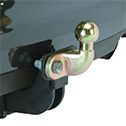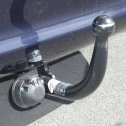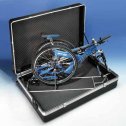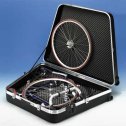Bike Carriers/Cycle Rack Buying Guide
Bike Carriers/Cycle Rack Buying Guide
The aim of these pages is to help you decide how to carry your bikes/cycles. On top of the car? Behind it? Both?
Having decided which type of carrier(s) to buy you'll then need to decide which model(s). Which features matter to you? How much do you want to spend? The good news is that there are some guidelines to help you through this maze...
> Considerations
> Roof mounting bike/cycle carriers
> Tow ball mounting bike/cycle carriers
> Rear door mounting bike/cycle carriers
> Spare wheel mounting bike/cycle racks
> 'In car' mounting bike/cycle carriers
> Tandem bike/cycle carriers
> Bike/cycle Boxes, Bags and Cases
> Scenarios A & B
First of all, please consider the following questions and answers / observations:
- How many bikes/cycles am I likely to want to carry, now and over (say) the next five years?
Unless you have a 4 x 4 (with tow bar nose weight of 100kg or more) you can't carry more than 4 bikes/cycles behind the car, and you can't normally carry more than 4 bikes/cycles on the roof. (So if you're carrying 5 bikes/cycles, at least one almost always goes on the roof or in the back of the car!) - What else do we need to put on the roof?
Note that a 'long medium wide' box is generally big enough for a family of five and you can still (usually) carry 2 bikes/cycles next to it. - Do I have a tow bar fitted, and am I prepared to invest in a tow bar for each new car I buy in the next few years?
Many people fit tow balls specifically for bike/cycle carrying purposes. The cost of the tow ball is peanuts compared to the depreciation on the car! (Get the garage to throw it in as part of the deal.) The total cost of good quality systems is in fact very similar, whether they are roof or tow ball mounted. - Do I need to tow and carry bikes/cycles at the same time?
Check the permitted tow bar nose weight and the length of the caravan or trailer drawbar; you might still get 2 bikes on a tow bar carrier. (MaxxRaxx swan neck tow bar cycle carriers allow for towing and bike/cycle carrying at the same time, and have a 'height extender' accessory to clear e.g. jockey wheels.) We supply a drawbar mounted adapter for carrying wheel support racks (which you can then transfer to the car when you park up the trailer / caravan). - Which types of cycle carrier are available for my vehicle, and how many bikes/cycles can be carried on each type?
This is a key question which usually narrows the options considerably! Note that
> You can always carry bikes/cycles on a tow ball.
> You can carry bikes/cycles on the roof unless you have a soft top, 'moon roof', or a car whose roof bars are too close together to hold bike/cycle carriers safely - a problem with certain three door coupes. (If our roof bars database says 'No fit', even though the Thule application list has a fitting, it's because the bars are too close together to be safe for load carrying.)
Some other things to consider:
- One roof mounting carrier is required for each bike/cycle.
- If using a tow bar cycle rack, you must not exceed the maximum permitted tow ball nose weight, taking into account the weight of the carrier and the weight of the bikes/cycles.
- Most people will opt for a system which is easily transferred from vehicle to vehicle.
- Any need to open the tailgate, especially during the journey. (We strongly advise you to avoid any Strap On cycle carriers which pass a strap over the bumper).
- If you buy a tow ball cycle carrier it makes sense to choose one with the potential to fit to every type of tow ball.
- Am I tall and strong enough to lift bikes/cycles onto the roof?
Roof mounting cycle carriers
Either fork mounting or with a frame-holder which grabs the bike downtube. Good security - the bikes/cycles are locked to the carrier, the carrier can be locked to the bars, and the bikes/cycles are out of harm's way IF you watch out for overhead barriers and low branches, and AVOID multi-storey car parks and your own garage or car port. You'll probably be able to fit at least 4 bikes/cycles on the roof, or perhaps 2 or 3 bikes together with a long roof box. Most of these carriers will only fit to standard 32mm by 22mm roof bars or slotted oval shaped aluminium aerobars.
The decision about whether to go for steel carriers or relatively expensive aluminium carriers won't just be influenced by price. (Don't worry about corrosion; all the steel carriers we sell are made from polyester or powder coated rustproofed steel.) Apart from the CRUZ Bici-rack and Thule FreeRide (which hold tubes to 80mm) bike downtubes greater than 50mm diameter simply won't fit on the cheaper steel carriers. The Atera and Thule aluminium cycle carriers not only hold bigger downtubes, and look very smart, but they are also much easier to use. If you have to lean over towards the centre of the car you'll appreciate the benefits of a quick catch / quick release handle at shoulder height. Many people with 4 bikes/cycles will therefore choose to put two easier-to-use carriers in the middle of the roof, and cheaper ones on the sides.
It makes sense to fit a set of identically numbered locks if you have two or more roof mounting carriers. Where possible, we'll provide as many identically numbered locks and keys as we can, all for £10, taking into account your bike/cycle carriers, roof bars and roof box purchases.
Tow bar mounting bike/cycle carriers
These fit any standard 50mm tow ball, including detachable tow balls. Up to 4 bikes/cycles can be carried on most vehicles, including 4 x 4s with rear mounted spare wheels - it depends on the maximum permitted tow ball nose weight.

A 'bolt on' tow ball cycle carrier - fixed with 2 bolts to a mounting plate

A 'swan neck' tow ball cycle carrier - it just appears from under the bumper
There are two types of tow ball - 'bolt on' (sometimes known as "two bolt flange") and 'swan neck' (which includes detachable tow balls). Be warned that some makes of cycle carrier only fit to one type of tow ball or the other.
Tow balls are less expensive to fit than you might think - check out www.indespension.co.uk or phone them on 01274 478500 for your nearest dealer. Most franchised car dealers are ridiculously expensive - but try and negotiate a 'free' tow ball as part of the deal.
The cheaper racks are 'hang on' racks - you hang the bike/cycle from its crossbar. Bear in mind though that you'll need to add on at least £15 for a lighting board. An artificial cross bar is available for ladies' bikes and Y frame bikes, although generally it doesn't matter if one wheel is higher than the other. We do however recommend the use of artificial cross bars if these bikes/cycles are carried on the Thule HangOn 972 / 9708.
'Wheel support racks' do what they suggest - the bikes/cycles stand on their wheels. Special supports keep the bikes apart and prevent any rubbing damage (a feature of most 'hang on' racks unless the bikes/cycles are well padded). These supports can be easily folded down for storage. Wheel support racks always come complete with a lighting and number plate unit.
Some wheel support racks tilt, even with the bikes/cycles in place, to allow the tailgate to be opened. This is very handy, and probably essential if e.g. you have a dog.
The majority of wheel support racks are very quick to fit, and easy to load - although you may need to e.g. turn handlebars through 90 degrees. It makes sense to supplement any locks supplied with the carrier by threading a cable lock around all the bikes/cycles, and the carrier, passing this through the vehicle towing loop for additional security.
Note that you can never tow with a wheel support cycle rack in place, as the rack sticks out behind the tow ball. But you may be able to fit it to a trailer draw bar adapter.
Rear door mounting bike/cycle carriers
The cheaper 'strap on' carriers are relatively cheap, carrying up to 3 bikes/cycles. They are held on with straps and can be considered to be safe if used properly. They offer no protection whatsoever against theft, although as with all rear mounted carriers it's easy, and sensible for safety as well as security, to pass a cable lock around all of the bikes, the carrier, and the vehicle's rear towing loop. All the cycle carriers we sell can be left on when the boot is opened, although the bikes/cycles must be taken off first to avoid damaging the tailgate hinges, damaging your back, and the risks of the heavy tailgate crashing shut. (We recommend that you avoid any strap on carriers which have straps fitted below the bumper, as you'll need to take the whole lot off to open the tailgate – this is a dead waste of time and always exasperating!)
Most 'Y frame' and ladies' bikes/cycles will require an artificial cross bar, as the bikes should be held on their point of balance. Unbalanced bikes/cycles will be trying to twist the carrier, which is definitely not safe.
The Thule ClipOn and ClipOn High carriers use steel straps instead of fabric straps and are therefore intrinsically much safer. The ClipOn is a 3 bike/cycle hang on rack (requiring the use of an extra number plate board); the ClipOn High takes 2 bikes/cycles and is a wheel support rack which in most cases stands above the number plate and light cluster.
Atera and Thule make 'clamp on' wheel support cycle racks which will take up to 4 bikes. Each bike/cycle stands on its own wheel tray and there are car specific adapters, ensuring a certain and secure fit, with the bikes locked to the carrier and the carrier locked to the vehicle. The tailgate can be lifted with the carrier in place, and each carrier is designed to hold the bikes/cycles above the light cluster and number plate.
All rear door mounting cycle carriers are car specific. There are application lists on the Bike/Cycle Carriers product pages which tell you whether a product has been specifically approved for your car, how many bikes it will take, whether a lighting board is required, etc.. If you have particular questions about car racks / bike carriers, send them to us online or call us on 015396 21884 between 9am and 6pm Monday to Saturday. (We are always closed on Bank Holidays.)
Spare wheel mounting bike/cycle carriers
Pendle makes both a 'strap to the wheel' type carrier and one which fixes 'through the wheel' to a permanently mounted adapter plate. Details of these systems are on the Bike/Cycle Carriers product pages; if you have any questions about them, please contact us online or call us on 015396 21884.
‘In car’ mounting bike/cycle carriers
Thule produces an 'in car' carrier for MPVs and large 4 x 4s - ideal for teams taking their bikes/cycles to race meetings, for example. Details of these applications are on the Bike/Cycle Carriers product pages; if you have any questions about them, please contact us online or call us on 015396 21884.
Tandem cycle carriers (roof mounting)
Pendle makes a very robust and fully adjustable tandem cycle carrier which holds both the Captain’s and the Stoker’s seat tube, cross bar or down tube to provide excellent support and to minimise vibration. (It’s also available in fork mounting format - the Pendle Tandem “T”.) Atera makes a tandem version of its hydraulic BIKE LIFT which holds the tandem by the Captain’s handlebars and the Stoker’s seat.
Putting your bike/cycle in the car, or taking it on a train or aeroplane?

B & W bike.case

B & W bike.box
We stock a range of top quality bike/cycle carrying bags and boxes, made by B&W of Germany. Padded bags are OK for car and train transport, but don't offer sufficient protection for air travel where you need either a hard case - see pictures - or a much cheaper composite hard case / padded bag, giving hard case levels of protection to the most vulnerable bits of your bike/cycle. Please click here for details, or otherwise click on the Bike boxes link in the left hand menu bar.









